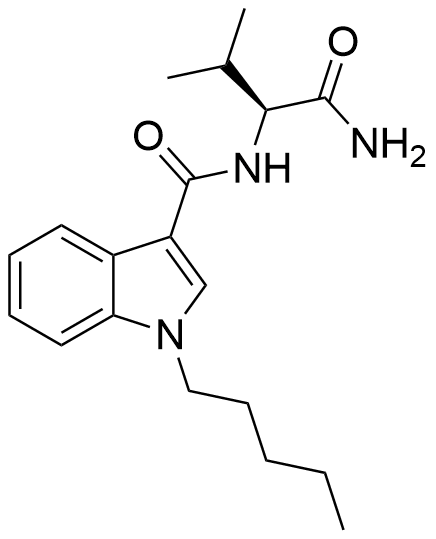Summary
AB-PICA exhibits significant potency as an agonist for both the CB1 receptor (with an EC50 of 12 nM) and the CB2 receptor (also with an EC50 of 12 nM).
| Identifiers | |
|---|---|
| IUPAC name | |
| CAS Number | 1801338-24-8 1445583-48-1 (racemate) |
|---|---|
| UNII | BWQ0BJ2OGXQ71G788A6H |
| Chemical and physical data | |
| Formula | C19H27N3O2 |
| Molar mass | 329.444 g·mol−1 |

fAQ
1. What is AB-PICA?
AB-PICA is a synthetic compound categorized as a synthetic cannabinoid. It is known for interacting with the CB1 and CB2 receptors in the endocannabinoid system.
2. What are CB1 and CB2 receptors?
CB1 and CB2 receptors are part of the endocannabinoid system, a complex cell-signalling system in the body. CB1 receptors are primarily found in the brain, while CB2 receptors are more prevalent in immune cells. Both receptors play a role in regulating various physiological processes.
3. How does AB-PICA interact with CB1 and CB2 receptors?
AB-PICA acts as an agonist, meaning it binds to and activates both CB1 and CB2 receptors. This interaction can lead to various physiological effects, depending on the receptor’s location and function.
4. What is the EC50 of AB-PICA for CB1 and CB2 receptors?
AB-PICA demonstrates significant potency, with an EC50 of 12 nM for CB1 and CB2 receptors. This indicates its ability to activate these receptors at a low concentration effectively.
5. What are the potential effects of AB-PICA on the body?
The specific effects of AB-PICA can vary, but they may include altered mood, perception, and relaxation due to its interaction with the endocannabinoid system. However, it’s important to note that the use of synthetic cannabinoids can have unpredictable and potentially harmful effects.
6. Is AB-PICA legal and safe to use?
The legal status of AB-PICA varies by region and country. Its safety is a subject of concern, as synthetic cannabinoids can have adverse effects and health risks. It is essential to stay informed about local regulations and exercise caution when using them.
7. Can AB-PICA be used for medical purposes?
Research on the potential medical applications of AB-PICA is limited. It is primarily considered a recreational or designer drug, and its use for medical purposes is not established.
8. What are the risks associated with AB-PICA use?
Using synthetic cannabinoids like AB-PICA can pose various risks, including unpredictable effects, adverse reactions, and potential legal consequences. Long-term health effects are still not well understood.
9. How can I learn more about AB-PICA and its effects?
It’s essential to rely on reputable sources and scientific literature to gather information about AB-PICA. Consult with healthcare professionals or experts for accurate and up-to-date insights.
10. Where can I find support for substance abuse or addiction related to synthetic cannabinoids?
If you or someone you know is struggling with substance abuse or addiction, there are organizations and resources available to assist. Seek help from addiction treatment centres or support groups for guidance and support.
References
- Banister SD, Moir M, Stuart J, Kevin RC, Wood KE, Longworth M, et al. (September 2015). “Pharmacology of Indole and Indazole Synthetic Cannabinoid Designer Drugs AB-FUBINACA, ADB-FUBINACA, AB-PINACA, ADB-PINACA, 5F-AB-PINACA, 5F-ADB-PINACA, ADBICA, and 5F-ADBICA”. ACS Chemical Neuroscience. 6 (9): 1546–59. doi:10.1021/acschemneuro.5b00112. PMID26134475.